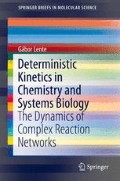Abstract
This chapter overviews analytical and numerical techniques of solving rate equations. For the analytical methods, the problems are divided into the group of single-concentration rate equations, which can typically be solved analytically, and the group of multiple-concentration rate equations, for which analytical solutions are seldom available. The explicit mathematical formulas of kinetic traces for all practically significant schemes are given in this chapter with advice on their application. Three different numerical integration methods are presented, which can give the approximate solution of any rate equation. The fundamentals of least squares curve fitting are also described, and methods for calculating standard errors and correlation coefficients are also given.
Access this chapter
Tax calculation will be finalised at checkout
Purchases are for personal use only
Notes
- 1.
In a common description of this technique, the equation is said to be “multiplied” by the term dt and then “integrated.” This method is often ridiculed by mathematicians, who point out that dt is part of a symbol on the left side, which does not have anything to do with division. Instead of joining the laughter, it is probably better to think a little bit about the fact that the method always gives the correct solution of the problem. In fact, this method also has rigorous mathematical background. It is called nonstandard analysis [16], where derivatives can be defined as a ratio of two infinitesimal quantities. But it is true that those who practice this method rarely have any ideas of the existence on nonstandard analysis.
- 2.
Hungarian-born mathematician Pál Erdős often told his audience that God has a book for recording the most elegant proofs of all theorems. As he used to say, mathematicians need not believe in God, but all of them must believe in the book. The author is sure this proof is from God’s book.
References
COPASI: http://www.copasi.org/
Curtiss, C.F., Hirschfelder, J.O.: Integration of stiff equations. Proc. Natl. Acad. Sci. USA 38, 235–243 (1952)
Deming, W.E.: Statistical Adjustment of Data. Wiley, New York (1943)
Érdi, P., Lente, G.: Stochastic Chemical Kinetics—Theory and (Mostly) Systems Biological Applications. Springer, New York (2014)
Gear, C.W.: The automatic integration of ordinary differential equations. Commun. ACM 14, 176–179 (1971)
KINSIM/FITSIM: http://www.biochem.wustl.edu/cflab/message.html
Kutta, W.: Beitrag zur näherungweisen Integration totaler Differentialgleichungen. Z. Math. Phys. 46, 435–453 (1901)
Lente, G., Fábián, I.: Effect of dissolved oxygen on the oxidation of dithionate ion. Extremely Unusual Kinetic Traces. Inorg. Chem. 43, 4019–4025 (2004)
Lente, G.: Stochastic mapping of first order reaction networks: a systematic comparison of the stochastic and deterministic kinetic approaches. J. Chem. Phys. 137, 164101 (2012)
Lente, G.: Kinetics of irreversible consecutive processes with first order second steps: analytical solutions. J. Math. Chem. DOI: 10.1007/s10910-015-0477-7 (2015)
McKay, H.A.C.: Kinetics of exchange reactions. Nature 142, 997–998 (1938)
McKay, H.A.C.: Kinetics of some exchange reactions of the type RI + I*- RI* + I- in alcoholic solution. J. Am. Chem. Soc. 65, 702–706 (1943)
Michaelis, L., Menten, M.L.: Die kinetik der invertinwirkung. Biochem. Z. 49, 333–369 (1913)
Micromath Scientist: http://www.micromath.com/
Pro-KIV Kinetic Analysis and Data Simulation Software: http://www.photophysics.com/software/pro-kiv-kinetic-analysis-data-simulation-software
Robinson, A.: Non-standard Analysis. Princeton University Press, Princeton (1974)
Runge, C., König, H.: Vorlesungen über Numerisches Rechnen. Springer, Berlin (1924)
SPECFIT Global Analysis: http://www.hi-techsci.com/products/specfitglobalanalysis/
ZiTa by G. Peintler: http://www.staff.u-szeged.hu/~peintler/enprogs.htm
Author information
Authors and Affiliations
Rights and permissions
Copyright information
© 2015 Gábor Lente
About this chapter
Cite this chapter
Lente, G. (2015). Solving Rate Equations. In: Deterministic Kinetics in Chemistry and Systems Biology. SpringerBriefs in Molecular Science. Springer, Cham. https://doi.org/10.1007/978-3-319-15482-4_2
Download citation
DOI: https://doi.org/10.1007/978-3-319-15482-4_2
Published:
Publisher Name: Springer, Cham
Print ISBN: 978-3-319-15481-7
Online ISBN: 978-3-319-15482-4
eBook Packages: Chemistry and Materials ScienceChemistry and Material Science (R0)

